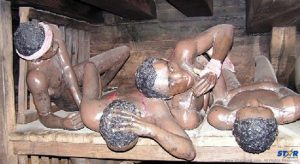http://stluciastar.com/numbers-deny-slavery-holocaust-claims/Numbers deny slavery holocaust claims
By Michael Dingwell
One of the reasons why it is being claimed that there was a holocaust during slavery is the number of slaves sent to the British Caribbean compared to the number of slaves who were alive in 1834. The “small” fraction of remaining slaves has been cited as a strong case for these holocaust claims. However, a good look at the numbers will reveal that there was indeed no holocaust.
Jamaica’s case can be used as the standard for most of the British Caribbean. It is claimed that the three hundred thousand slaves that remained out of the over one million that were imported proves that a holocaust occurred. However, any statistician who values his credibility will tell you that population growth is not so straight-forward.
 Caption: Was the African slave trade comparable to the Jewish Holocaust?
Caption: Was the African slave trade comparable to the Jewish Holocaust?Looking at the figures, we can see what the true population would have been without slavery. The 1.2 million slaves that were imported were shipped to Jamaica between 1650 and 1810. As such, the average yearly importation would be seven thousand five hundred slaves. Two-thirds of the imports were male – a very important population growth consideration.
It must be noted that while the average life expectancy of a slave in the 1600s was under thirty years, that for the rest of the world wasn’t much better – just under forty, at best. Excluding slavery, and considering that Africans were imported during the prime of their lives, we can expect that the average person would live for another twenty years once here.
As such, after twenty years, Jamaica’s slave population would have been one hundred and fifty thousand (the seven thousand five hundred yearly importation times the twenty years). However, the following year that number would drop by a third – on account of the fact that two thirds of the slave importation was male. Therefore, after the death of half of the males, on account of an inability to reproduce, the population would be one hundred thousand in around 1670.
After 1670, the population replacement mechanism (PRM) would chip in, as the new slave imports would just be replacing those who would have been here twenty years before – and who would have died. As such, the true population base and year that should be used to determine the population of Jamaica without slavery in 1830 was one hundred thousand and 1670 respectively. Now, what was the non-slavery growth rate like?
Up to the first few decades of the 1800s, the global population was growing slowly. Rapid growth actually started in the mid-1800s. Between the years 1600 and 1800, the world’s population grew from five hundred million to nine hundred million or eighty percent. In the absence of any credible birth, death or infant mortality rates for Jamaica at that time, the global growth rate must be applied. That would move Jamaica’s African population, without slavery, in 1830, to one hundred and eighty thousand.
Now some will argue that conditions in a Jamaican society without slavery would still have been much better than in Africa. As such, I will be very generous and increase that number by a further eighty percent, to over three hundred and twenty thousand. This is very consistent with the three hundred thousand slaves in Jamaica at that time.
Even if we should inflate the variables some more, there is no way that Jamaica’s African population in 1830 would be anywhere near one million, as some would want us to believe. The same is also true of the other British islands. As such, it is very clear: As far as the African population in the British Caribbean is concerned, there was no slavery holocaust.
